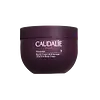What's inside
What's inside
 Key Ingredients
Key Ingredients

No key ingredients
 Benefits
Benefits

No benefits
 Concerns
Concerns

 Ingredients Side-by-side
Ingredients Side-by-side

Water
Skin ConditioningCoco-Caprylate/Caprate
EmollientGlycerin
HumectantVitis Vinifera Seed Oil
EmollientButyrospermum Parkii Butter Extract
Skin ConditioningButylene Glycol
HumectantHexyldecyl Stearate
EmollientIsocetyl Stearate
EmollientOctyldodecyl Myristate
EmollientArachidyl Alcohol
EmollientGlyceryl Stearate
EmollientPalmitoyl Grape Seed Extract
Skin ConditioningBehenyl Alcohol
EmollientPalmitic Acid
EmollientStearic Acid
CleansingArachidyl Glucoside
EmulsifyingPentaerythrityl Distearate
EmulsifyingPolyacrylate Crosspolymer-6
Emulsion StabilisingCaprylyl Glycol
EmollientEthylhexylglycerin
Skin ConditioningSodium PCA
HumectantPotassium Sorbate
PreservativeXanthan Gum
EmulsifyingLimonene
PerfumingTocopherol
AntioxidantHelianthus Annuus Seed Oil
EmollientLinalool
PerfumingIris Florentina Root Extract
MaskingCitric Acid
BufferingGeraniol
PerfumingSodium Phytate
Parfum
MaskingCitral
PerfumingWater, Coco-Caprylate/Caprate, Glycerin, Vitis Vinifera Seed Oil, Butyrospermum Parkii Butter Extract, Butylene Glycol, Hexyldecyl Stearate, Isocetyl Stearate, Octyldodecyl Myristate, Arachidyl Alcohol, Glyceryl Stearate, Palmitoyl Grape Seed Extract, Behenyl Alcohol, Palmitic Acid, Stearic Acid, Arachidyl Glucoside, Pentaerythrityl Distearate, Polyacrylate Crosspolymer-6, Caprylyl Glycol, Ethylhexylglycerin, Sodium PCA, Potassium Sorbate, Xanthan Gum, Limonene, Tocopherol, Helianthus Annuus Seed Oil, Linalool, Iris Florentina Root Extract, Citric Acid, Geraniol, Sodium Phytate, Parfum, Citral
Ingredients Explained
These ingredients are found in both products.
Ingredients higher up in an ingredient list are typically present in a larger amount.
Citral is a fragrance and used to add a lemon-like scent to products. It is both naturally found in plants and created synthetically. In plants, it is commonly occurring in lemon myrtle, lemongrass, lemon tea-tree, lemon verbena, and other citruses.
The EU mandates Citral be listed separately as a fragrance. It is a known allergen and may cause contact dermatitis. Citral can also used as a masking ingredient.
The term 'fragrance' is not regulated in many countries. In many cases, it is up to the brand to define this term. For instance, many brands choose to label themselves as "fragrance-free" because they are not using synthetic fragrances. However, their products may still contain ingredients such as essential oils that are considered a fragrance.
The term 'citral' is a collective term for two geometric isomers: geranial/Citral A and neral/Citral B.
Learn more about CitralGeraniol is used to add fragrance/parfum to a product. It is the main component of citronellol. It is a monoterpenoid and an alcohol.
Monoterpenes are naturally found in many parts of different plants.
Geraniol can be found in many essential oils including Rose Oil and Citronella Oil. The scent of Geraniol is often described as "rose-like". Many foods also contain Geraniol for fruit flavoring.
Geraniol can irritate the skin when exposed to air. However, irritation depends on the ability of geraniol to penetrate into the skin. In general, geraniol is not able to penetrate skin easily.
Geraniol is colorless and has low water-solubility. However, it is soluble in common organic solvents.
Like citronellol, it is a natural insect repellent.
2,6-Octadien-1-ol, 3,7-dimethyl-, (2E)-
Learn more about GeraniolLimonene is a fragrance that adds scent and taste to a formulation.
It's found in the peel oil of citrus fruits and other plants such as lavender and eucalyptus. The scent of limonene is generally described as "sweet citrus".
Limonene acts as an antioxidant, meaning it helps neutralize free radicals.
When exposed to air, oxidized limonene may sensitize the skin. Because of this, limonene is often avoided by people with sensitive skin.
The term 'fragrance' is not regulated in many countries. In many cases, it is up to the brand to define this term. For instance, many brands choose to label themselves as "fragrance-free" because they are not using synthetic fragrances. However, their products may still contain ingredients such as essential oils that are considered a fragrance.
Learn more about LimoneneLinalool is a fragrance and helps add scent to products. It's derived from common plants such as cinnamon, mint, citrus, and lavender.
Like Limonene, this ingredient oxidizes when exposed to air. Oxidized linalool can cause allergies and skin sensitivity.
This ingredient has a scent that is floral, spicy tropical, and citrus-like.
Learn more about Linalool